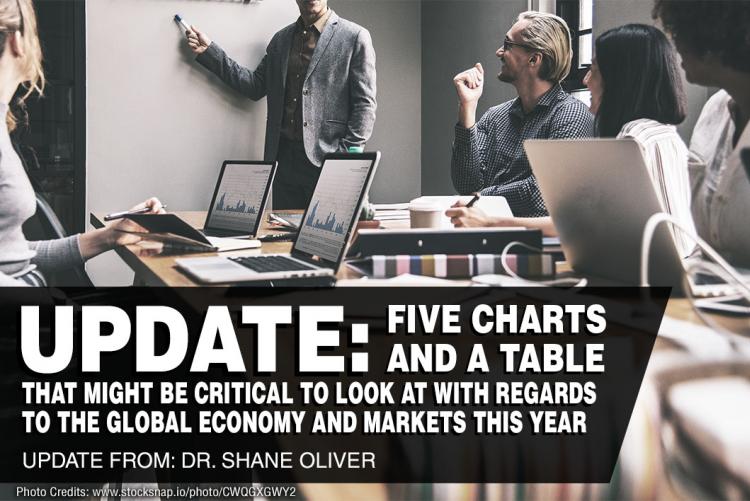- After having a solid rebound as a result of December share markets seems to be prone to a short-period pull back. Nonetheless, despite this, we come across this year from being a decent year with regards to share market profits.
- Five key worldwide charts to look at whether or not this is going to be the case are: global business situation PMIs; global inflation; the US bring forth curve; the US dollar; and global trade development.
- US economic decline parameters continue to be ok, but the yield curve is valued at watching.
- Good so far, however, the PMIs really do need to stabilize soon and of course, the trade threat requires to tend to diminish.

Initially, i ran against a range of five charts to focus your attention on with regards to the global economy last September. Since that timeshare markets plunged into December and also have since rebounded. The rebound has actually been great, but we have observed such rebounds before just to look at weakness resume so forth its own it doesn't prove we're away from the woods. It’s uncommon for US shares to get a deep V recovery following a 20% or along lines of that falls as spotted a year ago. With share markets getting run hard from their December lows as well as precisely overbought some kind of short-period pullback is a higher risk. But is going to it be the resumption of the decline in shares that all started a year ago or perhaps just a pullback setting the scene for the following leg higher? Our view is the idea that it will more likely function as the latter. We don’t see an imminent US, global or Australian recession. And of course, the swing now in progress towards more dovish/stimulating global economic coverage along with diminishing trade war threats would likely drive tougher global economic growth with the 2nd half of the year. Thus, this year is predicted to ultimately give good profits for shares.
Needless to say, nobody really knows for definite so this note revisits the five charts we come across as critical by which way it will inevitably go on and adds a table on US financial crisis risks to watch.
Chart 1 – Global business conditions PMIs
Global Purchasing Managers Indexes (PMIs) – studies of buying managers at organizations in many major countries – usually are good and well-timed tips for the condition of the global economy. Each of these remains remarkable however they have already been falling during the last year suggesting slowing growth (as taken place into 2012 and 2016). There are a number of indications of stabilization in the United States; however, they might want to boost more broadly to become according to our view that progress will pick-up in the second half of the entire year. At the very least they're really a good distance from recessionary readings.

Source: Bloomberg, AMP Capital
Chart 2 – Global inflation
Major economic down times are necessarily preceded by the spiking of inflation to mentioned above central bank targets resulting in central banks to actually slam the brakes on. At the moment, primary inflation in major global economies is harmless. In the US core inflation is merely below the Fed’s 2% inflation target, which actually in addition to headwinds to growth has made possible the Fed to pause its rate of interest hikes. Inflation in China has actually been falling and is actually significantly less than the Government’s 3% target/forecast. And rising prices within the Eurozone and Japan looks good below target and offers no constraint to continuing policy stimulus having the ECB more likely to soon announce an additional round of cheap finance for banks. A transparent rise in core inflation would be considered a warning sign of vigorous monetary tightening being connected, however, this continues getting slowed down by events just like last year’s global growth slowdown as well as oil price crumple.

Source: Bloomberg, AMP Capital
Chart 3 – The US yield curve
The yield angle is basically a tip for the perspective of monetary policy. In the event that short-period rates of interest are very low relative to long-term rates businesses can obtain short and lend (or make investments) long which certainly grows the economic system. But it’s not exactly good once short rates are beyond long rates. An inverted US yield curve already has preceded US recessions. So, once it’s going in this direction a few worries. And it's been lately, with both of your the gap between the 10-year bond yield and of course the Fed Funds rate plus the gap amongst the 2- year bond yield plus the Fed Funds rate flattening at present.

Source: Bloomberg, AMP Capital
However, there are quite a few points to allow for. First, the yield curve can provide false signals (circled on the chart) and of course, the lags from within an inverted curve to a financial crisis can be just about 15 months. So if it inverted now recession might not come till mid the following year and history indicate the share market has peaked 3-6 months before recessions, so it could be exceedingly far away for marketplaces to look for.
Next, a range of factors might be flattening the yield curve which might be not related to economic growth such as near zero German , as well as Japanese bond yields holding down US yields and high investor demand for bonds, put up the GFC as they demonstrated being a good diversifier – rallying every time shares to have a major fall.
Third, other indicators say that US monetary policy is way from tight – the real Fed Fund amount is barely positive, plus the nominal Fed Funds amount is significantly less than nominal GDP growth and they are both off from levels that previously have preceded US recessions.
So now the yield curve will probably be worth keeping track of – especially now it’s flashing amber – but its shortcomings really need to be permitted for.
Chart 4 – The US dollar
Different from moves generally in most individual currencies, that happen to be only of relevance towards the country they actually are among, flows in the $US seems to be of wide-ranging global significance. It is because of its reserve currency condition and also that a large amount of global debt is designated in US dollars especially in developing countries. So whenever the $US surges like in 2015 and a year ago it simply makes it tough for rising countries. Additionally it depresses US company earnings with a lag.

Source: Bloomberg, AMP Capital
This has been the case currently considering the rising US dollar towards a great deal of currencies such as rising market currencies as revealed in our 4th chart, contributing to problems in a number of emerging countries. Additionally strong gains in the united states dollar, for instance, the Fed goes on to hike dangers increasing developing market worries and of course the risks that it poses to worldwide growth (just like the developing world is approximately 60% of worldwide GDP). By contrast, if the US dollar balances, the pressure on rising countries will probably have receded.
Chart 5 – World trade growth
Just quite lately there's been much argument whether or not the era of globalization is due an end and this resulted in a peak in world trade. This might be for considerably benign considerations as solutions end up being an ever-greater part of the financial activity and producing turns into less labour reliant. But it may additionally be as a consequence of rising protectionism with US policies under Trump a significant threat. It’s early days so far with just about 12% of US imports being dependent upon increased tariffs for a regular tariff increase all over all US imports of just 1.6% (right after the latest tranche is carried out). This can be a long way from 1930 that in fact saw all US imports subject to a 20% tariff hike along with other countries do the same thing. While we still look at a negotiated option, it might not come till following the US mid-term elections. Global trade growth already has achieved over the past couple of years however it recently began to slow a bit. It’s too early for this year’s trade conflict to appear in trade data but it’s worth observing this chart as more slowly global trade growth would probably pose a threat to global economic growth.

Source: Bloomberg, AMP Capital
Concluding comments
On balance, all of these indicators imply the outlook continues to be okay. Possibly the greatest near-term risks are currently in existence the US dollar and Trump’s trade war. Beyond this, repeated indicators still are okay. And even though we haven’t had space to fit it in right here the indications of cyclical unnecessary that have the ability to precede major economic down times – eg, really strong wages development and a high level of cyclical spending (buyer durable, housing possibilities and financial commitment) as a part of GDP – aren’t significantly evident in the US and are also a long way away from being evident in various other major countries.

